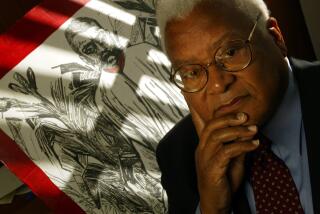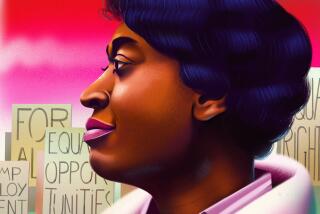Jervis Anderson; Journalist and Biographer
- Share via
Martin Luther King Jr. symbolizes the civil rights movement for young Americans. But others played major roles, including the late Bayard Rustin, who organized the 1963 march on Washington where King delivered his famous “I Have a Dream” speech, celebrated today across the nation.
Jervis Anderson, a journalist born in Jamaica, wanted younger generations to know Rustin, to know A. Philip Randolph, who conceived the 1963 march, and to understand the lives of other African Americans who helped blacks gain a place in the United States. So he wrote.
Anderson wrote for the New Yorker for 30 years. And he wrote learned biographies, among them the 1997 “Bayard Rustin: Troubles I’ve Seen” and the 1973 “A. Philip Randolph: A Biographical Portrait.”
The writer, who was 67, was found dead in his New York City apartment on Jan. 7, after neighbors saw that his mail and newspapers were going uncollected. Officials said Anderson died of natural causes sometime during the holidays.
To portray black life and those who lived it, Anderson did not always dwell on racial hardships. Reviewers praised his books as a “joyous voyage of discovery.”
“I thought,” Anderson once said in an interview, “that the story of the human character of the culture should be told.”
His ability to do just that was clearly illustrated in his 1982 book “This Was Harlem: A Cultural Portrait, 1900-50.” First serialized in the New Yorker, the book described the storied Manhattan enclave as “crowded with energy, crowded with talent, crowded with style.” Anderson further observed that the blacks who lived there were “blessed or cursed with a wonderful optimism.”
In reviewing “This Was Harlem” for The Times, Claremont Graduate School history professor Robert Dawidoff praised Anderson’s “keen sense that Harlem was one of the great subjects of 20th century American Art.” Dawidoff likened Anderson’s “well-written” history to Duke Ellington’s musical descriptions of Harlem and its illustrious inhabitants.
“ ‘This Was Harlem’ makes marvelous reading, typical of the best nonfiction in the New Yorker,” Dawidoff wrote. “Anderson sees how freedom and restriction encouraged a development of style and substance that still dazzles.”
Anderson himself came from a middle-class life in Jamaica, where his father was a contractor and builder. He attended Kingston Technical School at Kingston’s University of the West Indies and became a reporter on the island’s leading newspaper, the Daily Gleaner. He also wrote regularly for Public Opinion, a weekly magazine edited by the father of independence leader Michael Manley.
Anderson moved to New York in 1958 to study literature at New York University, earning both bachelor’s and master’s degrees. A decade later he joined the New Yorker where he remained until his retirement in 1998.
Considered an independent intellectual and a man of letters, Anderson pursued information about those who intrigued him. The first of his four well-received books, also serialized in the New Yorker, was published in 1973. It chronicled the life of Randolph, the man who founded and led the Brotherhood of Sleeping Car Porters, a union of railroad employees, and later was the namesake for the A. Philip Randolph Institute, which Rustin headed.
Anderson, who once worked at Randolph’s institute, gave readers of the Randolph biography what one reviewer termed “a view of personal integrity, character and dedication that . . . seems to have vanished entirely from the American scene.”
Although Anderson had no restrictions on his topics at the New Yorker, he often chafed at what he saw as editors’ preference that black writers concentrate solely on black subjects.
So in 1984, shortly after his successful book on Harlem, he published the pan-racial “Guns in American Life.”
A Times reviewer praised that book as “admirably researched and put together” with impressive statistics, anecdotes illustrating societal trends and Anderson’s own reasoned observations.
One of those observations was Anderson’s insight about use of guns in movies and on television: “Unless it was the blowing of a kiss, nothing looked easier on the screen than pulling a trigger that released an invisible and impersonal bullet. No human contact was necessary.”
Anderson earned a National Endowment for the Humanities grant to work on the Bayard Rustin biography.
Commenting on the resulting book, a Times reviewer wrote: “Anderson’s strength is his consistent reliability as a reporter, as well as his attention to detail. . . . [His] book reads like a belated and rather detailed obituary of a second-stringer, who happened to advise King and get into scraps with other guys like Stokely Carmichael before being consigned to the sidelines of the civil rights leadership. . . . Anderson has penned a tribute to a modern Renaissance man whom he considers the ‘shrewdest theoretician’ and ‘most talented organizer’ of the civil rights movement.”
At the time of his death, Anderson was still writing, working on a book about his own youth in Jamaica and another about novelist Ralph Ellison.
More to Read
Sign up for our Book Club newsletter
Get the latest news, events and more from the Los Angeles Times Book Club, and help us get L.A. reading and talking.
You may occasionally receive promotional content from the Los Angeles Times.






